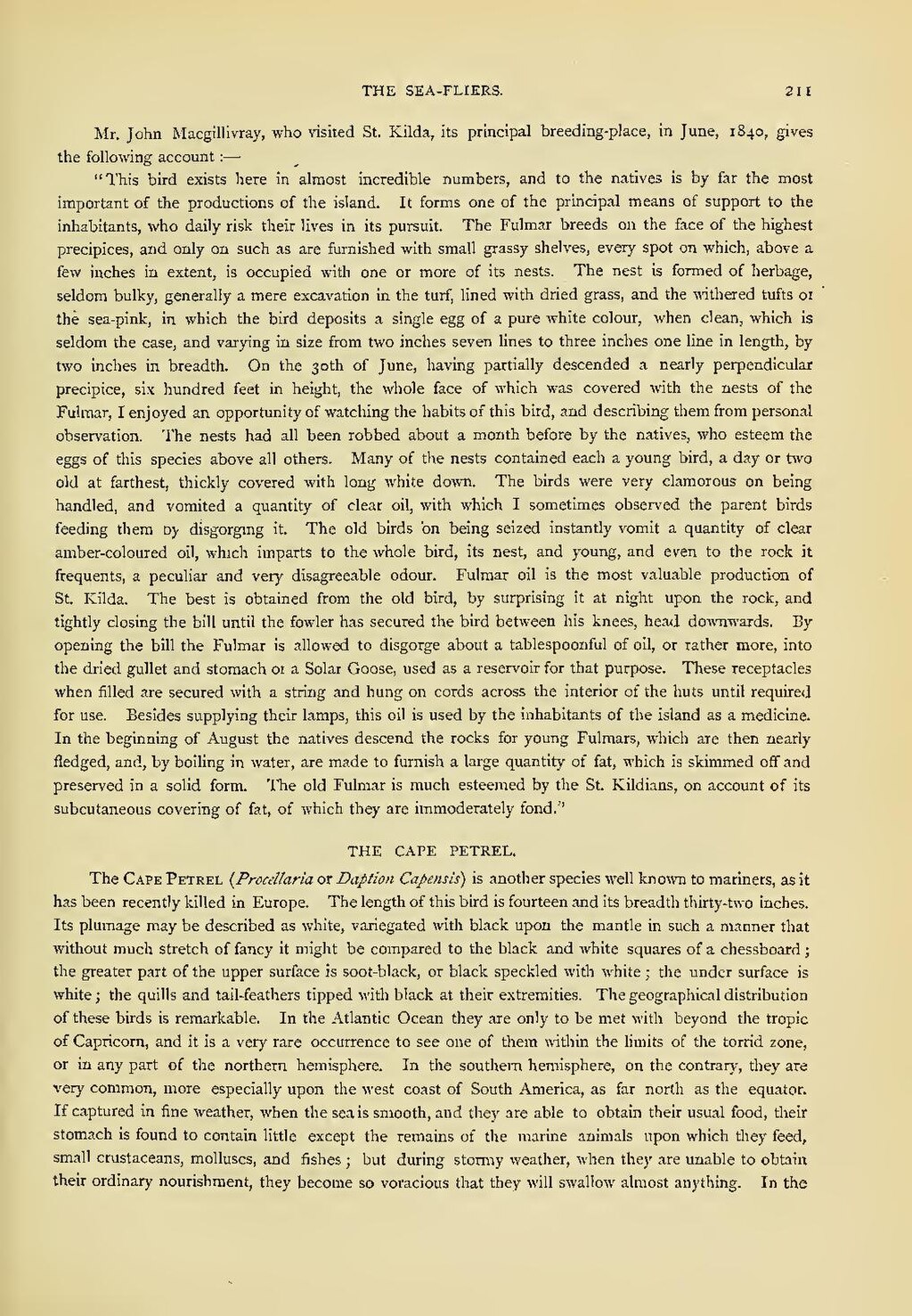Mr. John Macgillivray, who visited St. Kilda, its principal breeding-place, in June, 1840, gives the following account:—
"This bird exists here in almost incredible numbers, and to the natives is by far the most important of the productions of the island. It forms one of the principal means of support to the inhabitants, who daily risk their lives in its pursuit. The Fulmar breeds on the face of the highest precipices, and only on such as are furnished with small grassy shelves, every spot on which, above a few inches in extent, is occupied with one or more of its nests. The nest is formed of herbage, seldom bulky, generally a mere excavation in the turf, lined with dried grass, and the withered tufts or the sea-pink, in which the bird deposits a single egg of a pure white colour, when clean, which is seldom the case, and varying in size from two inches seven lines to three inches one line in length, by two inches in breadth. On the 30th of June, having partially descended a nearly perpendicular precipice, six hundred feet in height, the whole face of which was covered with the nests of the Fulmar, I enjoyed an opportunity of watching the habits of this bird, and describing them from personal observation. The nests had all been robbed about a month before by the natives, who esteem the eggs of this species above all others. Many of the nests contained each a young bird, a day or two old at farthest, thickly covered with long white down. The birds were very clamorous on being handled, and vomited a quantity of clear oil, with which I sometimes observed the parent birds feeding them by disgorging it. The old birds on being seized instantly vomit a quantity of clear amber-coloured oil, which imparts to the whole bird, its nest, and young, and even to the rock it frequents, a peculiar and very disagreeable odour. Fulmar oil is the most valuable production of St. Kilda. The best is obtained from the old bird, by surprising it at night upon the rock, and tightly closing the bill until the fowler has secured the bird between his knees, head downwards. By opening the bill the Fulmar is allowed to disgorge about a tablespoonful of oil, or rather more, into the dried gullet and stomach of a Solar Goose, used as a reservoir for that purpose. These receptacles when filled are secured with a string and hung on cords across the interior of the huts until required for use. Besides supplying their lamps, this oil is used by the inhabitants of the island as a medicine. In the beginning of August the natives descend the rocks for young Fulmars, which are then nearly fledged, and, by boiling in water, are made to furnish a large quantity of fat, which is skimmed off and preserved in a solid form. The old Fulmar is much esteemed by the St. Kildians, on account of its subcutaneous covering of fat, of which they are immoderately fond."
THE CAPE PETREL.
The Cape Petrel (Procellaria or Daption Capensis) is another species well known to mariners, as it has been recently killed in Europe. The length of this bird is fourteen and its breadth thirty-two inches. Its plumage may be described as white, variegated with black upon the mantle in such a manner that without much stretch of fancy it might be compared to the black and white squares of a chessboard; the greater part of the upper surface is soot-black, or black speckled with white; the under surface is white; the quills and tail-feathers tipped with black at their extremities. The geographical distribution of these birds is remarkable. In the Atlantic Ocean they are only to be met with beyond the tropic of Capricorn, and it is a very rare occurrence to see one of them within the limits of the torrid zone, or in any part of the northern hemisphere. In the southern hemisphere, on the contrary, they are very common, more especially upon the west coast of South America, as far north as the equator. If captured in fine weather, when the sea is smooth, and they are able to obtain their usual food, their stomach is found to contain little except the remains of the marine animals upon which they feed, small crustaceans, molluscs, and fishes; but during stormy weather, when they are unable to obtain their ordinary nourishment, they become so voracious that they will swallow almost anything. In the
